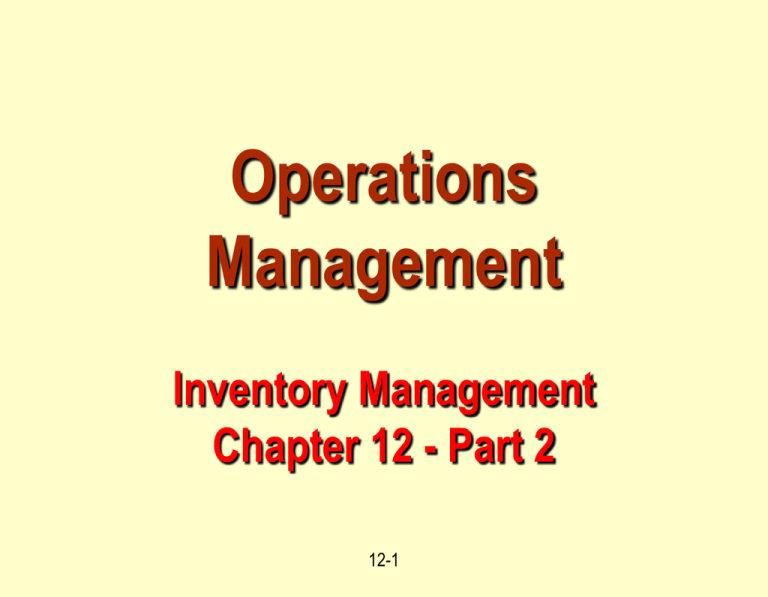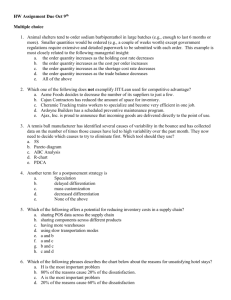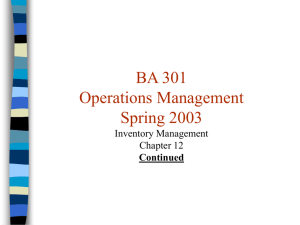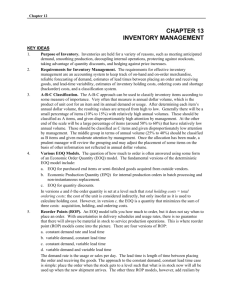Chapter 1, Heizer/Render, 5th edition
advertisement

Operations Management Inventory Management Chapter 12 - Part 2 12-1 Outline Functions of Inventory. ABC Analysis. Inventory Costs. Inventory Models for Independent Demand. Economic Order Quantity (EOQ) Model. Production Order Quantity (POQ) Model. Quantity Discount Models. Probabilistic Models for Varying Demand. Fixed Period Systems. 12-2 Production Order Quantity Model Material is not received instantaneously. For example, it is produced in-house. Other EOQ assumptions apply. Model provides production lot size (like EOQ amount) for one product. Similar to EOQ with setup cost rather than order cost. 12-3 Production Order Quantity Model Consider one product at a time. Produce Q units in a production run; then switch and produce other products. Later produce Q more units in 2nd production run (Q units of product of interest). Later produce Q more units in 3rd production run, etc. 12-4 POQ Model Inventory Levels Inventory Level Production portion of cycle Demand portion of cycle with no production (of this product) Time Production Begins Production Run Ends 12-5 POQ Model Inventory Levels Inventory Level Production rate = p = 20/day Demand rate = d = 7/day Slope = p-d = 13/day Slope = -d = -7/day Time Production Begins Production Run Ends Note: Not all of production goes into inventory 12-6 POQ Model Inventory Levels Inventory Level Production rate = p = 20/day Demand rate = d = 7/day Slope = p-d = 13/day Inventory increases by 13 each day while producing Slope = -d = -7/day Inventory decreases by 7/day after producing Time Production Begins Production Run Ends Note: 1-(d/p) = fraction of production that goes into inventory 12-7 POQ Model Equations D = Annual demand (relatively constant) S = Setup cost per setup H = Holding (carrying) cost per unit per year d = Demand rate (units per day, units per week, etc.) p = Production rate (units per day, units per week, etc.) Given Determine: Q = Production run size (number of items per production run) Number of Production Runs per year = Setup Cost per year = D S Q D Q Holding Cost per year = (average inventory level) H 12-8 POQ Model Inventory Levels Inventory Level Maximum Inventory = Q(1-(d/p)) Production Portion of Cycle Time Demand portion of cycle with no supply 12-9 POQ Model Equations D = Annual demand (relatively constant) S = Setup cost per setup H = Holding (carrying) cost per unit per year d = Demand rate (units per day, units per week, etc.) p = Production rate (units per day, units per week, etc.) Given Determine: Q = Production run size (number of items per production run) Number of Production Runs per year = Setup Cost per year = D S Q D Q Q Holding Cost per year = (ave. inventory level) H = H [1-(d/p)] 2 12-10 POQ Model Equations D = Annual demand S = Setup cost per setup H = Holding (carrying) cost per unit per year d = Demand rate p = Production rate Optimal Production Run Size = Q* = Maximum inventory level = Q [1- (d/p)] Total Cost = D Q S+ H [1-(d/p)] Q 2 12-11 2 ×D ×S = H[1-(d/p)] Given 2DS H p p-d Run Length & Cycle Length Inventory Level Production Run length (time) = Q /p Time Cycle length (time) = Q /d 12-12 POQ Example Demand = 1000/year (of product A) Setup cost = $100/setup Holding cost = $20 per year per item Production rate = 10/day 365 working days per year Qp* = Demand rate = d = 1000/365 = 2.74/day 2 ×1000×100 = 117.36 units/run 20×[1-(2.74/10)] Maximum inventory level = 117.36 [1- (2.74/10)] = 85.2 units Total Cost = 1000 117.36 = 852.08 100 + + 117.36 2 20 [1-(2.74/10)] 852.03 12-13 = $1704.11/year POQ Example Demand = 1000 units/year Production rate = 10 units/day Qp* = 117.36 units per run 42.8 Demand rate = d = 1000/365 = 2.74/day 11.74 Production run length = 117.36/(10/day) = 11.74 days Cycle length = 117.36/(2.74/day) = 42.8 days Number of production runs per year = 1000/117.36 = 8.52 12-14 Robustness of POQ POQ is robust (like EOQ): Can adjust production run size. Useful even when parameters are uncertain. A large (20%) change in parameters or operations will cause a small (~2%) change in total costs. Production run size (Q) and run length (Q/p) can be adjusted to fit normal business cycles. 12-15 POQ Robustness Example Set production run length to 14 days (2 weeks) rather than 11.74 days (as was optimal). Q/p = 14 days means that: Q = 10x14 = 140 units Q = 140 is 19% over optimal value of 117.4 units. Cycle length = Q/d = 140/2.74 = 51.1 days. Total cost = $1730.68 Only 1.6% over minimum cost with optimal Q! 12-16 POQ & Multiple Products POQ computes a production run size for a single product. For multiple products made on the same equipment: 1. Compute POQ, run time, and cycle time for each product. 2. Find a common cycle time for all products. 3. Recalculate run time and cycle time, so the common cycle time is a multiple of each product’s cycle time. 4. Fit production runs into largest cycle time. 12-17 Multiple Products Example Example: Company makes 3 products: A, B, C A: Optimal run time = 3 days; Optimal cycle time = 10 days B: Optimal run time = 6 days; Optimal cycle time = 18 days C: Optimal run time = 10 days; Optimal cycle time = 33 days A A 3 7 3 A 7 3 7 B B 6 6 12 C 23 10 12-18 12 Multiple Products Example Optimal run time and cycle time: A: Run time = 3 days; Cycle time = 10 days (1 run/10 days) B: Run time = 6 days; Cycle time = 18 days (1 run/18 days) C: Run time = 10 days; Cycle time = 33 days (1 run/33 days) Use 30 days as a common cycle; adjust run & cycle times: A: Run time = 3 days; Cycle time = 10 days (3 runs/30 days) B: Run time = 5 days; Cycle time = 15 days (2 runs/30 days) C: Run time = 9 days; Cycle time = 30 days (1 run/30 days) A B C A B A 3 5 9 3 5 3 2 days idle time 12-19 Quantity Discount Model Variation of EOQ (not POQ). Allows quantity discounts. Reduced price for purchasing larger quantities. Other EOQ assumptions apply. Trade-off lower price to purchase item & increased holding cost from more items. Total cost must include annual purchase cost. Total Cost = Order cost + Holding cost + Purchase cost 12-20 Quantity Discount Model - Holding Cost Holding cost: Depends on price. Usually expressed as a % of price per unit time. 20% of price per year, 2% of price per month, etc. I = Holding cost percent of price per year P = Price per unit H = Holding cost = IP 12-21 Quantity Discount Equations D = Annual demand S = Order cost per order H = Holding (carrying) cost = IP I = Inventory holding cost % per year P = Price per unit Order Quantity = Q* = Total Cost ($/yr) = 2 ×D ×S IP D Q S+ IP + PD Q 2 12-22 Annual purchase cost Quantity Discount Model Q <500 500-1000 1000 D = 1000/year S = $100/order I = 20% per year P $100 $ 95 $ 90 IP $20 $19 $18 To solve: 1. Find EOQ amount for each discount level. 2. If EOQ is not in range for discount level, adjust to the nearest end of range. 3. Calculate total cost for each discount level. 4. Select lowest cost and corresponding Q. 12-23 Quantity Discount Example Q <500 500-1000 1000 D = 1000/year S = $100/order I = 20% per year P $100 $ 95 $ 90 IP $20 $19 $18 1. P = $100 IP = $20 EOQ = 100 in range! Total Cost = 1,000 + 1,000 + 100,000 = $102,000/year 2. P = $95 IP = $19 EOQ = 102.6 not in range (500-1000)! Adjust to Q = 500 Total Cost = 200 + 4,750 + 95,000 = $99,950/year 12-24 Quantity Discount Example - cont. Q <500 500-1000 1000 D = 1000/year S = $100/order I = 20% per year P $100 $ 95 $ 90 3. P = $90 IP = $18 EOQ = 105.4 not in range (>1000)! Adjust to Q = 1000 Total Cost = 100 + 9,000 + 90,000 = $99,100/year Q Total costs <500 $102,100 500-1000 $ 99,950 1000 $ 99,100 Lowest cost, so order 1000 12-25 IP $20 $19 $18 Stockouts In basic EOQ model, demand and lead time are known and constant, so there should never be a stockout. If demand or lead time vary, then may have a stockout: Due to larger than expected demand. Due to longer than expected lead time. 12-26 Probabilistic Models Inventory Level Average demand Reorder Point (ROP) Place order Lead Time 12-27 Receive order Time Probabilistic Models - Stockout Inventory Level If demand is greater than average - then stockout Reorder Point (ROP) Place order Lead Time 12-28 Receive order Time Safety Stock to Reduce Stockouts Inventory Level Safety stock New ROP Old ROP Place order Lead Time 12-29 Receive order Time Safety Stock & Service Level Safety stock is inventory held to protect against stockout. Service level = 1 - Probability of stockout Service level of 95% means 5% chance of stockout. Higher service level means more safety stock. More safety stock means higher ROP. ROP = Expected demand during lead time + Safety stock 12-30 Probabilistic Models Demand follows normal distribution. d = Average demand rate per day. = Standard deviation of demand. ROP = d L + safety stock safety stock = ss = Z Z is from Standard Normal Table in Appendix I. 12-31 EOQ-based Models Order same amount every time = Q. Time between orders varies. ROP Time between 1st & 2nd order Time between 2nd & 3rd order 12-32 Time Fixed Period Model Order at fixed intervals (e.g., every 2 weeks). Order different amounts each time, based on amount on hand. If large amount on hand, then order small amount. If small amount on hand, then order large amount. Useful when vendors visit routinely. Example: P&G representative calls every 2 weeks. 12-33 Fixed Period Model Compute optimal order interval, T (equation is similar to EOQ). For example, 27.35 days Compute maximum inventory level, M (equation is similar to ROP). Adjust order interval to a convenient length. For example, one month. Then, adjust M correspondingly. Order M - inventory on hand every T time units. 12-34 Fixed Period Models Order at constant interval. Order amount Q varies: M - amount on hand. On-hand for order 2 On-hand for order 1 1st order 2nd order 12-35 3rd order Time




